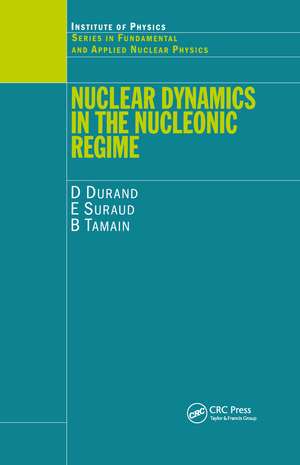Nuclear Dynamics in the Nucleonic Regime: Series in Fundamental and Applied Nuclear Physics
Autor D Durand, E Suraud, B Tamainen Limba Engleză Hardback – 21 noi 2000
Preț: 1352.42 lei
Preț vechi: 1896.26 lei
-29% Nou
Puncte Express: 2029
Preț estimativ în valută:
258.82€ • 269.21$ • 213.67£
258.82€ • 269.21$ • 213.67£
Comandă specială
Livrare economică 25 martie-08 aprilie
Doresc să fiu notificat când acest titlu va fi disponibil:
Se trimite...
Preluare comenzi: 021 569.72.76
Specificații
ISBN-13: 9780750305372
ISBN-10: 0750305371
Pagini: 320
Dimensiuni: 156 x 234 x 23 mm
Greutate: 0.66 kg
Ediția:1
Editura: CRC Press
Colecția CRC Press
Seria Series in Fundamental and Applied Nuclear Physics
ISBN-10: 0750305371
Pagini: 320
Dimensiuni: 156 x 234 x 23 mm
Greutate: 0.66 kg
Ediția:1
Editura: CRC Press
Colecția CRC Press
Seria Series in Fundamental and Applied Nuclear Physics
Public țintă
ProfessionalCuprins
Introduction. Some basic properties of nuclei: static and statistical concepts. Macroscopic and microscopic descriptions of heavy-ion collisions. Basic experimental and analysis tools. Reaction mechanisms. Fast processes towards thermalization. Decay modes of hot nuclei: from evaporation to vaporisation. Nuclear fragmentation and the liquid-gas phase transition. Epilogue. Appendix. References. Index.
Descriere
Over the last decade one of the most active areas of research in nuclear physics has been the study of systems of nucleons in various dynamical situations. Heavy-ion collisions at beam energies in the range 30-150 MeV per nucleon, where subnucleaonic degrees of freedom can be considered as frozen, allow such systems to be studied in detail. This book summarizes our current understanding of this branch of physics. The authors follow the course of typical heavy-ion collisions through time and discuss each stage of the collisions. By presenting experimental and theoretical understanding, a clear picture of the physics can be presented.


